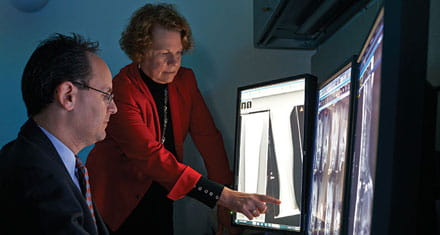Cutting to the Bone

Dr. Hostetter checks the extent of a patient’s bone infection with radiologist Daniel Podberesky, MD.
Perplexing Infection Prompts Breakthrough Research
It should have been routine. The child had a serious bone infection, but a common one: osteomyelitis.
A bacterium we all carry on our skin, Staph aureus, had entered his body.
It went to a bone in his leg and set off a nasty infection. It was painful enough to bring him to the emergency room.
We knew exactly what to do.
He’d have to spend a few days in the hospital. We’d attack the infection with intravenous (IV) antibiotics that would get the medicine into his bloodstream fast. After that blast of medicine, he’d be able to go home.
He’d complete another four to six weeks of treatment with IV and oral antibiotics at home. And that would be that. He’d be fine.
It didn’t work that way.
About the time he should have been packing up to go home, he was being transferred to the pediatric intensive care unit.
When he should have been back to school and playing with his friends, he was fighting for his life against a raging infection that had spread through his body.
Cases like this are rare, representing about 5 percent of all osteomyelitis cases seen at Cincinnati Children’s.
Peggy Hostetter, MD, director of the Division of Infectious Diseases, wanted to understand why an infection that is easily controlled in most patients takes such an unusual and dangerous turn in some children.
Her research results shed new light on the genetics that impact the course of osteomyelitis − and may allow us to predict which patients are at risk for massive infection and need unusually aggressive care right from the start.
Hostetter is convinced that the high volume of patients at Cincinnati Children’s, one of the largest pediatric hospitals in the country, reveals a problem that might not be noticed at smaller hospitals, where doctors may not see this rare complication, or not see enough cases to recognize and study it.
“Even if I saw one such child at a smaller institution, I wouldn’t see others,” she says. “I would think, ‘This is a weird accident. Something’s the matter here.’ But I wouldn’t be able to figure it out.”
Hunting for the Explanation
Hostetter started by studying information about seven children. She found no pattern. There were boys and girls. They ranged from 2 to 16 years old. They were not related. There was no underlying medical condition. They had all been healthy before this bone infection. Some had methicillin sensitive Staph aureus; others had methicillin resistant Staph aureus. No one in their families had ever required hospitalization. There were no mistakes in their care. The children had been correctly diagnosed and had been given the appropriate treatment.
So, she reasoned, there must be a genetic mutation in the child. How to find it?
She turned for advice to a research colleague at Cincinnati Children’s, John Harley, MD, director of the Center for Autoimmune Genomics and Etiology. He suggested − in the language of genomic scientists − whole exome sequencing of trios.
That meant, look at the part of the genes that contributes to making proteins − the exon. Map out the precise order (sequence) of the four molecules that make up the genetic code of each exon. Do this for all 23,000 genes for each child and each child’s parents (the trio).
And once you have all that information, hunt for genetic variants.
With the computer power and expert bioinformatic analysis available to researchers at Cincinnati Children’s, it’s possible to do studies involving millions or billions of bits of data.
Finding the Culprit
Four families agreed to provide blood samples from the child and both parents so Hostetter could study their DNA. She hoped to find gene variants that could explain what happened to these children.
She did.
“As a fetus develops, its DNA replicates very rapidly,” Hostetter explains.
“Mutations occur. Every one of us has about 25,000 variants.” These genetic changes occur in the child and are not inherited from the parents. For the most part, they don’t cause harm.
Hostetter was looking for harmful variants, changes that would damage normal functioning of protein in skin, bone or the immune system. “In each of the kids we studied, we found a variant that made a lot of sense,” she says. Using a prediction program, she found that the variants “were predicted to be highly damaging, in the sense that the protein wouldn’t be able to work right.” Because of these harmful genetic variants, the Staph aureus bacteria was able to enter the body more easily and infect the bone. The variants also explain why the bone couldn’t contain the infection, allowing it to spread throughout the body.
Predict and Prevent
Hostetter hopes to use this discovery to improve care for future patients, “because this extreme infection is a nasty surprise when it happens. It’s a nasty surprise from the doctor’s standpoint. Imagine how the parents feel.”
The next phase of her research is to create a gene chip that can test for these damaging mutations.
Hostetter envisions the day when a simple test would identify children at risk for overwhelming Staphylococcal infection as soon as they enter the hospital, before they go into a downward spiral. Those children would receive much more aggressive care, including extremely high-dose bactericidal antibiotics and perhaps orthopaedic surgery to remove the original site of the infection to minimize the chances of spread.
Preventing the nightmare scenario that puts some children in the ICU with a life-threatening infection would be a distinctive contribution from Cincinnati Children’s.




